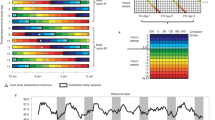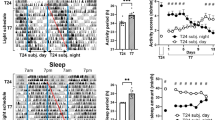Abstract
The idea of ameliorating jetlag with drugs has received considerable attention. Melatonin has been found to reduce feelings of jetlag in people after transatlantic flights1. In hamsters, injections of triazolam, a benzodiazepine, increase the rate of adjustment of activity rhythms to an 8 h advance of the light-dark (LD) cycle2. But melatonin can make people drowsy and triazolam often induces hamsters to run in their wheels2,3. Therefore, it is not clear whether these chemicals exert their chronotypic effects by acting directly on circadian pacemakers or because they first alter behavioural states. Non-photic behavioural events (for instance, social interactions) are capable of entraining rhythms and causing phase shifts4. Thus, it is possible that behavioural events alone could alter the rate of adjustment to new LD cycles. To investigate this possibility, we studied the rate of re-entrainment of hamsters in a testing paradigm similar to that used with triazolam2. We found that the rate of adjustment could be more than doubled simply by making the animals active on a single occasion in the middle of their normal rest period, immediately after the shift in the LD cycle.
This is a preview of subscription content, access via your institution
Access options
Subscribe to this journal
Receive 51 print issues and online access
$199.00 per year
only $3.90 per issue
Buy this article
- Purchase on Springer Link
- Instant access to full article PDF
Prices may be subject to local taxes which are calculated during checkout
Similar content being viewed by others
References
1. Arendt, J., Maldhous, M. & Marks, V. Br. med. J. 292, 1170 (1986). 2. Van Reeth, O. & Turek, F. W. Am. J. Phys. 253, tf204-207 (1987). 3. Turek, F. W. & Losee-Olson, S. Nature 321, 167-168 (1986). 4. Mrosovsky, N. J. comp. Physiol. 162 (1987). 5. Lees, J. G., Hallonquist, J. D. & Mrosovsky, N. J. comp. Physiol. 153, 123-132 (1983). 6. Klein, K. E. & Wegmann, H. M. in Chronobiology (eds Scheving, L. E., Halberg, F. & Pauly, J. E.) 564-570 (Igaku Shoin, Tokyo, 1974).
Author information
Authors and Affiliations
Rights and permissions
About this article
Cite this article
Mrosovsky, N., Salmon, P. A behavioural method for accelerating re-entrainment of rhythms to new light—dark cycles. Nature 330, 372–373 (1987). https://doi.org/10.1038/330372a0
Received:
Accepted:
Issue Date:
DOI: https://doi.org/10.1038/330372a0
This article is cited by
-
Circadian rhythm as a therapeutic target
Nature Reviews Drug Discovery (2021)
-
Chocolate for breakfast prevents circadian desynchrony in experimental models of jet-lag and shift-work
Scientific Reports (2020)
-
Vestibular stimulation by 2G hypergravity modifies resynchronization in temperature rhythm in rats
Scientific Reports (2020)
-
Exercise as a synchroniser of human circadian rhythms: an update and discussion of the methodological problems
European Journal of Applied Physiology (2007)
-
“Orphan” phenotypes in gerontological research
Aging Clinical and Experimental Research (1993)
Comments
By submitting a comment you agree to abide by our Terms and Community Guidelines. If you find something abusive or that does not comply with our terms or guidelines please flag it as inappropriate.



